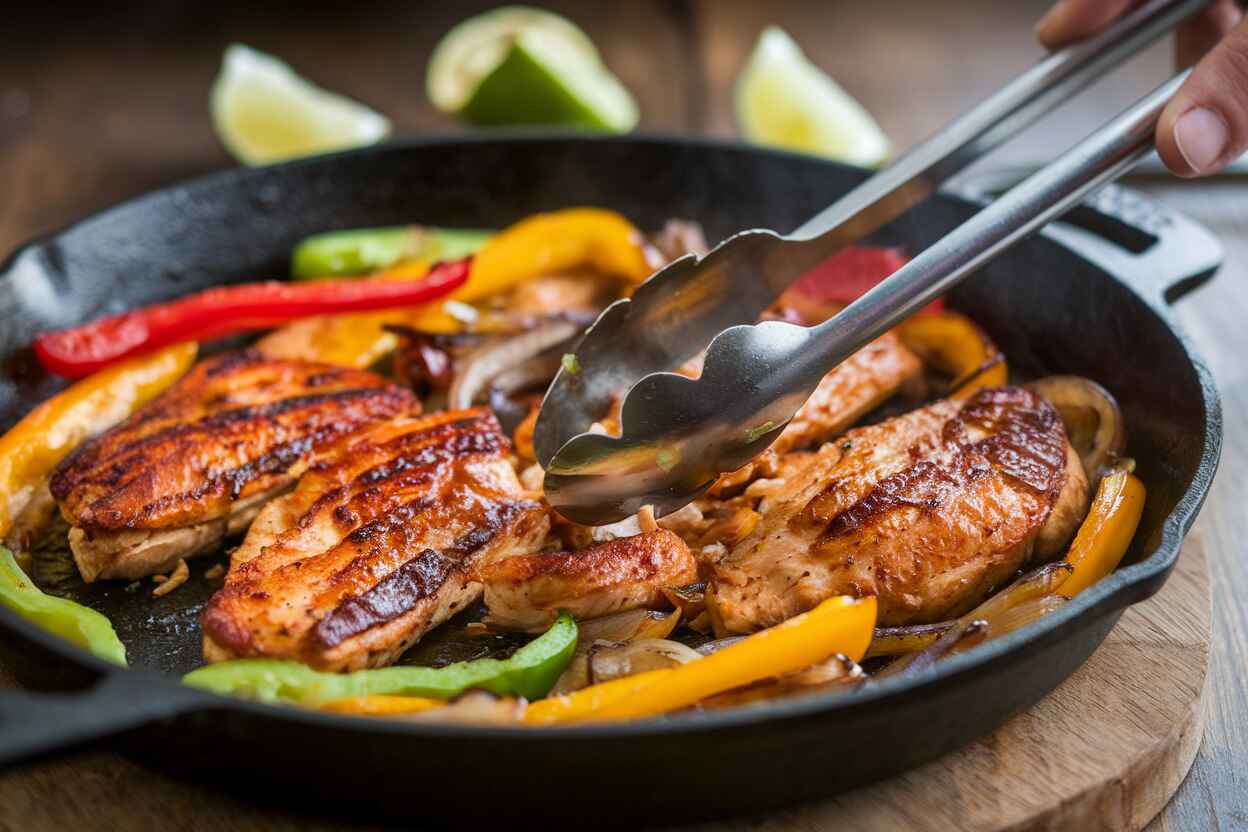Fajitas de pollo are one of the most beloved Mexican dishes, known for their sizzling presentation, bold flavors, and endless customization options. Whether you enjoy them wrapped in warm tortillas, served over rice, or piled high with your favorite toppings, these fajitas are an easy yet satisfying meal.
In this guide, I’ll walk you through everything you need to know about making the perfect fajitas de pollo, from choosing the right ingredients to cooking them to perfection. Plus, I’ll share my personal tips, favorite toppings, and a bonus recipe for a creamy chipotle lime sauce to take your fajitas to the next level!
Table of Contents
What Are Fajitas de Pollo?
The term “fajitas” comes from the Spanish word “faja,” meaning strip or belt, which refers to the way the meat is sliced. While traditional fajitas are made with beef, fajitas de pollo (chicken fajitas) have become a widely popular variation.
This dish consists of thinly sliced, well-seasoned chicken breast or thighs, sautéed with colorful bell peppers and onions. Everything is cooked in a sizzling hot skillet, infusing the ingredients with bold, smoky flavors. Served with warm tortillas and an array of toppings, fajitas de pollo are a simple yet incredibly flavorful meal that can be enjoyed any night of the week.
My First Experience with Fajitas de Pollo: A Personal Story
The first time I tried fajitas de pollo, I was immediately hooked! I still remember the sound of the sizzling pan being brought to the table at my favorite Mexican restaurant. The aroma of smoky spices, caramelized onions, and perfectly grilled chicken filled the air. As I took my first bite, wrapped in a soft tortilla with fresh guacamole and a dollop of sour cream, I knew I had found one of my all-time favorite meals.
That experience led me to experiment in my own kitchen, determined to recreate those bold flavors at home. After several attempts, I discovered the secrets to making restaurant-quality fajitas—from the perfect seasoning blend to cooking techniques that keep the chicken juicy and flavorful. Now, I’m excited to share everything I’ve learned with you!
Essential Ingredients for Authentic Fajitas de Pollo
To make the best fajitas de pollo, you’ll need a few key ingredients. While there’s plenty of room for customization, sticking to these essentials will ensure a classic and authentic flavor.
- Chicken: Boneless, skinless chicken breasts or thighs work best. Thighs offer more juiciness, while breasts cook quickly and absorb flavor well.
- Bell Peppers: A mix of red, yellow, and green bell peppers adds sweetness, crunch, and color to your fajitas.
- Onions: White or yellow onions are traditionally used, adding a subtle sweetness when caramelized.
- Fajita Seasoning: A blend of chili powder, smoked paprika, cumin, garlic powder, onion powder, and a touch of cayenne pepper.
- Lime Juice: Fresh lime juice brightens up the flavors and adds a bit of tanginess.
- Olive Oil: Helps the seasoning stick and enhances the charred effect on the chicken.
- Tortillas: Warm flour or corn tortillas are essential for serving.
The Secret to Perfectly Seasoned Chicken
The seasoning is what truly makes fajitas de pollo stand out. While store-bought fajita seasoning works in a pinch, making your own allows you to control the flavors and avoid unnecessary additives.
Homemade Fajita Seasoning Blend
- 1 tablespoon chili powder
- 1 teaspoon smoked paprika
- 1 teaspoon ground cumin
- 1 teaspoon garlic powder
- 1 teaspoon onion powder
- ½ teaspoon cayenne pepper (optional for extra heat)
- ½ teaspoon salt
- ½ teaspoon black pepper
How to Properly Season the Chicken
- Coat the Chicken: In a large bowl, mix the chicken slices with olive oil and fresh lime juice.
- Add the Seasoning: Sprinkle the homemade fajita seasoning over the chicken, making sure each piece is well coated.
- Let It Marinate: For the best flavor, let the chicken marinate for at least 30 minutes (or up to 24 hours in the fridge).
- Cook to Perfection: Whether grilling or using a skillet, cook the chicken over medium-high heat to get a nice sear while keeping it juicy inside.
Pro Tip: Using a cast-iron skillet helps retain heat evenly and gives the chicken a perfect charred texture, just like restaurant fajitas.
Now that you have the perfect seasoning and ingredients ready, it’s time to dive into the cooking process! In the next section, I’ll cover different cooking methods to ensure your fajitas turn out just as delicious as your favorite restaurant’s version.
Cooking Methods: Skillet, Grill, or Oven?
Once your chicken is perfectly seasoned, it’s time to cook it. The best part? You have multiple options to get that sizzling, restaurant-style fajita experience at home. Let’s explore the most effective cooking methods for fajitas de pollo and how each one affects the flavor and texture.
1. Skillet Cooking (Best for Authentic Sizzle)
This is my go-to method when I want that classic fajita experience. Using a cast-iron skillet ensures even heat distribution and helps develop that flavorful sear on the chicken and veggies.
- Heat a cast-iron skillet over medium-high heat until it’s smoking hot.
- Cook the chicken first: Sear for about 5-7 minutes per side until golden brown and cooked through.
- Sauté the vegetables: Remove the chicken, then cook the bell peppers and onions in the same pan for an additional 4-5 minutes.
- Combine and serve: Slice the chicken, toss it back with the veggies, and serve immediately.
Pro Tip: Let the skillet get super hot before adding the chicken. This locks in the juices and creates that signature charred crust.
2. Grilling (Best for Smoky Flavor)
Grilling adds a smoky depth that takes fajitas to another level. If you have a grill, this method is worth trying!
- Preheat the grill to medium-high heat (about 400°F/200°C).
- Grill the whole chicken breast for 6-8 minutes per side.
- Slice after grilling: Let the chicken rest for a few minutes, then slice into strips.
- Grill the vegetables using a grill pan or foil packet for easy handling.
3. Oven Roasting (Best for Hands-Off Cooking)
If you’re making fajitas for a crowd, roasting everything on a sheet pan is a great option.
- Preheat oven to 425°F (220°C).
- Spread chicken and veggies on a lined baking sheet.
- Roast for 20-25 minutes, flipping halfway through.
- Slice and serve: Once cooked, slice the chicken into strips and mix with the roasted veggies.
Choosing the Best Peppers and Onions for Fajitas
When making fajitas de pollo, the right choice of peppers and onions can elevate the dish with layers of flavor, texture, and color. After plenty of experimenting, I’ve found that some varieties work better than others. Let’s break it down.
1. Best Peppers for Fajitas
- Red Bell Peppers: Sweet, mild, and rich in color. These balance out the smoky heat of fajita seasoning.
- Yellow & Orange Bell Peppers: Slightly sweeter than red peppers, they add brightness and contrast.
- Green Bell Peppers: Earthier and slightly bitter, these create a more traditional Tex-Mex taste.
- Poblano Peppers: Mildly spicy with a smoky depth, they’re great for adding complexity.
- Jalapeños: Perfect if you like heat! Slice them thinly or add roasted jalapeños for extra kick.
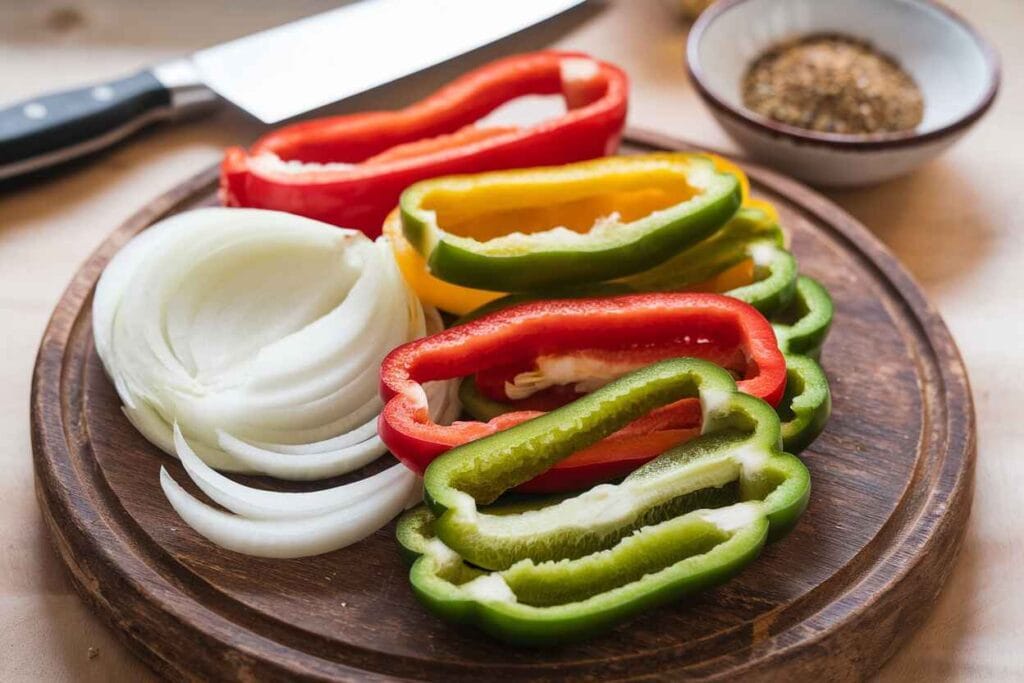
2. Best Onions for Fajitas
- Yellow Onions: My go-to choice. When sautéed, they develop a deep caramelized sweetness.
- White Onions: Stronger in flavor and more traditional in Tex-Mex cuisine.
- Red Onions: Slightly milder and slightly sweet—great for adding a pop of color.
Pro Tip: Slice peppers and onions into even strips to ensure they cook uniformly. For extra char, cook them in a super-hot cast-iron skillet.
Marinade vs. Dry Rub: Which is Better?
One of the most debated topics when making fajitas de pollo is whether to use a marinade or a dry rub. I’ve tried both countless times, and honestly, it depends on what you’re looking for.
1. Marinade: Best for Tender & Juicy Chicken
If I have time, I always marinate my chicken—it locks in moisture and infuses deep flavors. A great fajita marinade should include:
- Citrus Juice: Lime or orange juice for natural tenderizing.
- Olive Oil: Helps coat the chicken evenly.
- Smoked Spices: Paprika, cumin, and chili powder for deep, warm flavors.
- Fresh Garlic & Onion: Adds richness.
For best results, marinate for at least 30 minutes, or up to 24 hours.
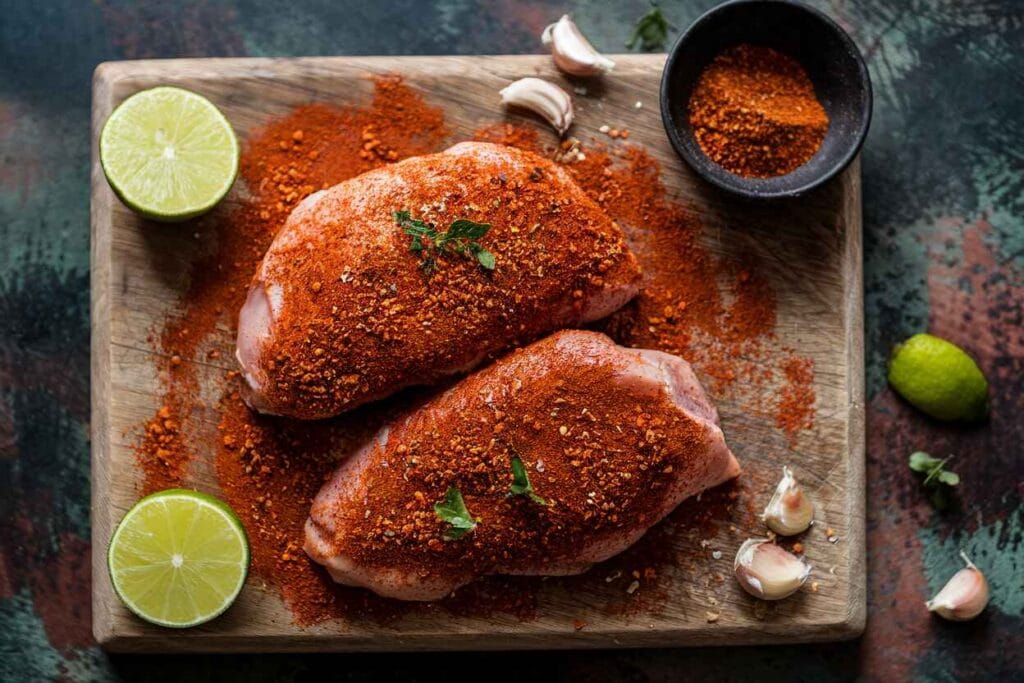
2. Dry Rub: Best for Bold, Spiced Flavor
When I’m short on time, I use a dry rub. It creates an intense spice crust without adding moisture. My favorite mix includes:
- Chili Powder & Smoked Paprika: For depth.
- Cumin & Garlic Powder: Essential Mexican flavors.
- Salt & Black Pepper: Balances everything out.
Which Should You Choose?
- For juicy, tender chicken: Marinade.
- For a bold spice crust: Dry rub.
- For the best of both: A quick marinade followed by a light dry rub before cooking.
Pro Tip: Always pat chicken dry before cooking to get a perfect sear.
Step-by-Step Guide: How to Make Fajitas de Pollo
If you want restaurant-quality fajitas de pollo at home, this foolproof guide will walk you through it. Let’s get started!
Step 1: Gather Ingredients
- 1 ½ lbs boneless, skinless chicken breasts or thighs
- 3 bell peppers (red, yellow, and green), sliced
- 1 large onion, sliced
- 2 tbsp olive oil
- 2 tbsp fajita seasoning (or homemade blend)
- Juice of 1 lime
- Flour or corn tortillas
Step 2: Season or Marinate the Chicken
- If using a marinade: Mix lime juice, olive oil, and spices. Coat chicken and marinate for at least 30 minutes.
- If using a dry rub: Pat chicken dry, coat with olive oil, and evenly sprinkle seasoning.
Step 3: Cook the Chicken
- Heat a large cast-iron skillet over medium-high heat.
- Cook chicken for 5-7 minutes per side, until internal temperature reaches 165°F (74°C).
- Let chicken rest for 5 minutes before slicing into strips.
Step 4: Sauté Peppers & Onions
- In the same skillet, add a bit more oil.
- Add sliced onions and bell peppers.
- Cook for about 4-5 minutes until slightly tender but still crisp.
Step 5: Assemble & Serve
- Warm tortillas on a dry skillet.
- Fill each tortilla with chicken, peppers, and onions.
- Top with guacamole, sour cream, cheese, or fresh lime juice.
Pro Tip: Want that restaurant-style char? Grill the chicken instead of using a skillet!
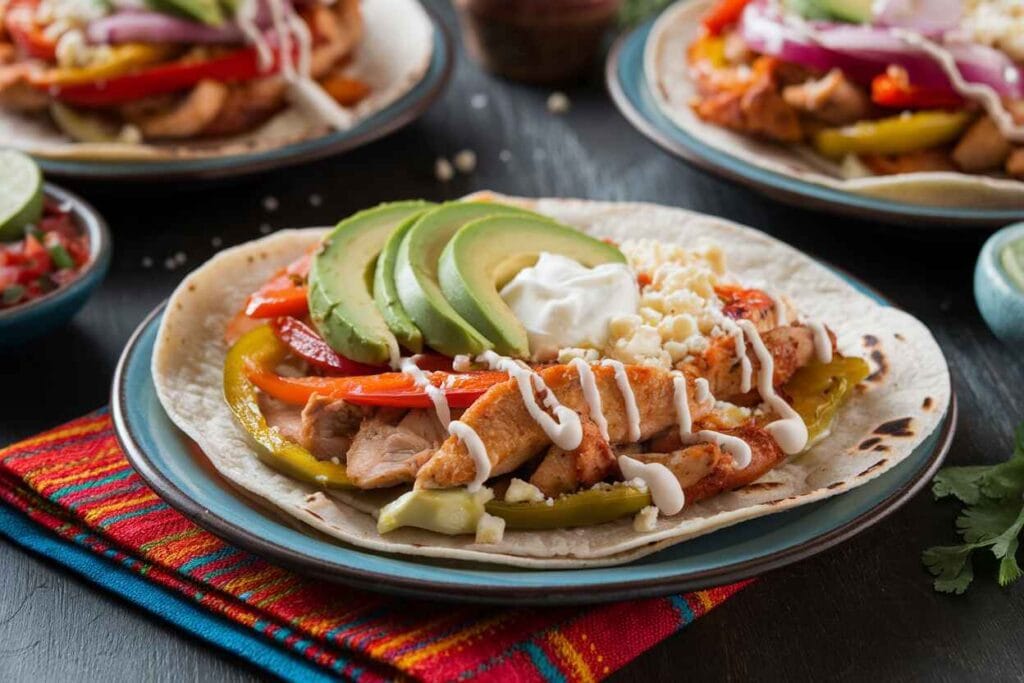
Common Mistakes to Avoid When Making Fajitas
Even though fajitas are relatively easy to make, a few common mistakes can affect the final result. Here’s what to watch out for:
1. Overcooking the Chicken
One of the biggest mistakes is drying out the chicken. To avoid this:
- Use boneless chicken thighs for extra juiciness.
- Cook just until the internal temperature reaches 165°F (74°C).
- Let the chicken rest before slicing to keep it moist.
2. Slicing Chicken Before Cooking
Always cook whole chicken breasts first, then slice them. This helps retain moisture and prevents the meat from drying out.
3. Cooking Vegetables Too Long
Bell peppers and onions should be slightly crisp, not mushy. Cook them over high heat for just 4-5 minutes.
4. Not Using Fresh Lime Juice
Bottled lime juice lacks the bright, fresh flavor that makes fajitas stand out. Always squeeze a fresh lime over your finished fajitas before serving!
Best Tortillas for Serving Fajitas de Pollo
Choosing the right tortillas can make or break your fajita experience. Here are my favorites:
Flour Tortillas (Soft & Chewy)
Flour tortillas are the classic choice for fajitas. They’re soft, pliable, and perfect for wrapping around juicy chicken and veggies.
Corn Tortillas (Traditional & Flavorful)
For a more authentic Mexican-style fajita, use corn tortillas. They add a subtle sweetness and complement the smoky fajita flavors beautifully.
Low-Carb Alternatives
- Lettuce wraps – A fresh, crunchy option.
- Almond flour tortillas – Great for keto diets.
- Whole wheat tortillas – A healthier alternative with extra fiber.
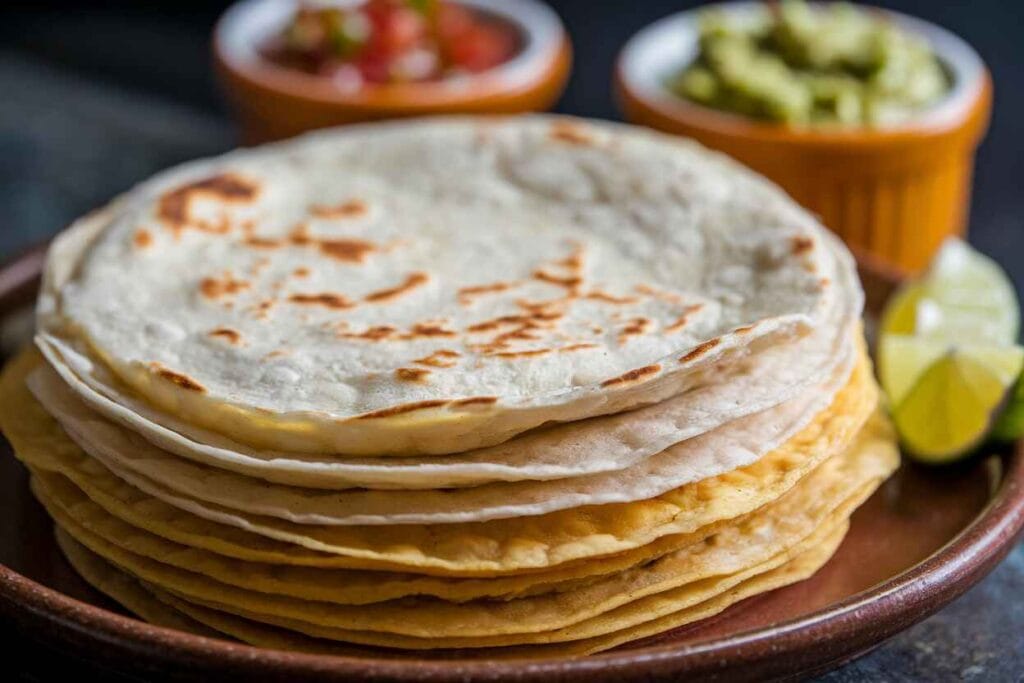
Toppings and Sides That Elevate Your Dish
No fajita feast is complete without the perfect toppings and side dishes. Here are my go-to favorites:
Classic Toppings
- Fresh Pico de Gallo – A simple mix of diced tomatoes, onions, cilantro, and lime juice.
- Guacamole – Creamy, rich, and packed with flavor.
- Shredded Cheese – Cheddar, Monterey Jack, or queso fresco.
- Sour Cream or Greek Yogurt – Adds a cool, tangy contrast.
Best Side Dishes
- Mexican Rice – A flavorful side that pairs perfectly with fajitas.
- Refried Beans – Creamy and packed with protein.
- Grilled Street Corn (Elote) – Sweet, smoky, and topped with cotija cheese.
Pro Tip: Warm your tortillas on a dry skillet for 30 seconds per side to make them soft and pliable!
Now that you know the best ways to cook fajitas, avoid common mistakes, and serve them with the perfect toppings, let’s take it a step further. In the next section, I’ll show you how to turn fajitas into a meal prep staple and explore their nutritional benefits.
How to Make Fajitas a Meal Prep Favorite
One of the reasons I absolutely love making fajitas de pollo is that they’re a lifesaver for meal prep! Whether I’m planning quick weekday lunches or a stress-free dinner option, fajitas are always a winner. With just a little prep work, I can have flavorful, ready-to-go fajitas whenever I need them. Let me show you how I keep my fajitas fresh, delicious, and meal-prep friendly.
1. Cook in Batches
I always make a double batch—because let’s be honest, fajitas taste just as good (if not better) the next day! Cooking everything at once means I have enough for multiple meals with minimal effort.
2. Store Components Separately
The biggest mistake I used to make was storing everything in one container. By keeping the chicken, vegetables, and tortillas separate, I avoid sogginess and preserve those fresh flavors.
3. Best Storage Methods
- Fridge: Store cooked fajita chicken and veggies in an airtight container for up to 4 days.
- Freezer: If I want to prep ahead, I freeze the cooked chicken and vegetables in a freezer-safe bag for up to 3 months.
4. How to Reheat
The key to reheating fajitas without drying them out is adding a little moisture. Here’s what works best for me:
- Skillet: I heat them in a dry pan over medium heat for about 5 minutes, stirring occasionally.
- Microwave: I cover the fajitas with a damp paper towel and microwave in 30-second intervals until heated through.
Pro Tip: If I freeze fajitas, I leave out the bell peppers and cook them fresh when I reheat. This keeps them crisp and flavorful!
Health Benefits of Fajitas de Pollo
Beyond being delicious, fajitas de pollo are packed with nutrition. They’re one of those meals I can enjoy without feeling guilty because they’re naturally balanced, high in protein, and full of wholesome ingredients.
1. High in Lean Protein
Chicken breast and thighs provide an excellent source of lean protein, keeping me full and fueling my muscles after workouts.
2. Loaded with Vitamins and Antioxidants
The bell peppers and onions in fajitas are packed with vitamins C and A, plus antioxidants that help support my immune system.
3. Naturally Low in Carbs
If I skip the tortillas or use lettuce wraps, fajitas make a fantastic low-carb meal option.
4. Heart-Healthy Fats
Adding avocado, guacamole, or a drizzle of olive oil provides essential healthy fats that are great for heart health.
5. Customizable for Different Diets
Whether I’m going for gluten-free, dairy-free, or high-protein meals, fajitas can be adjusted to fit just about any diet.
Pro Tip: I swap traditional tortillas for whole wheat or almond flour versions for extra fiber and nutrients.
Bonus Recipe: Spicy Chipotle Lime Crema
If there’s one thing that can take my fajitas to the next level, it’s a rich, smoky, and slightly spicy crema. This chipotle lime crema is my go-to sauce for drizzling over fajitas—it’s creamy, zesty, and absolutely addictive!
Ingredients:
- ½ cup sour cream (or Greek yogurt for a lighter version)
- 1 chipotle pepper in adobo sauce, finely chopped
- 1 tablespoon fresh lime juice
- ½ teaspoon garlic powder
- ½ teaspoon smoked paprika
- Salt to taste
Instructions:
- Mix all ingredients in a bowl until well combined.
- Adjust seasoning to taste—add more lime juice for tanginess or an extra chipotle pepper for more heat.
- Chill for at least 30 minutes to let the flavors meld.
- Drizzle over fajitas or use as a dipping sauce!
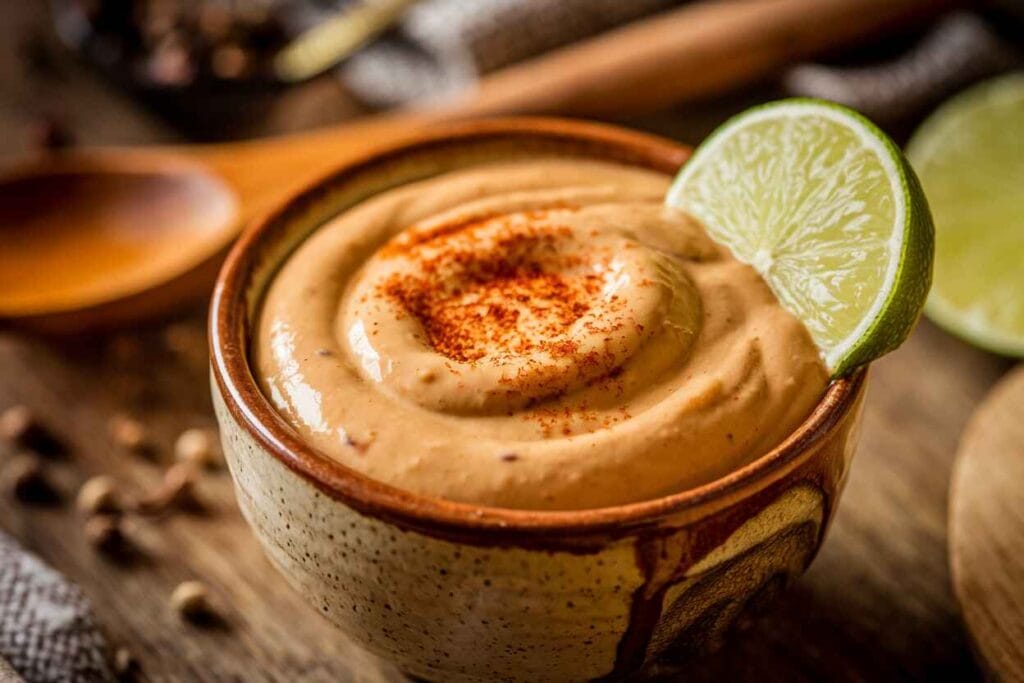
Pairing Fajitas de Pollo with the Perfect Drinks
Every great meal deserves a great drink, and fajitas are no exception! Whether I’m hosting a fajita night or just treating myself, these drinks always complement the meal perfectly.
Classic Refreshing Options
- Agua Fresca: Light, fruity, and refreshing, agua fresca (like watermelon or hibiscus) is a perfect non-alcoholic option.
- Horchata: A creamy, cinnamon-infused rice milk drink that balances out the smoky fajita flavors.
- Lime Sparkling Water: If I’m keeping it simple, lime-flavored sparkling water pairs perfectly with the citrusy notes in fajitas.
Pro Tip: If I’m making fajitas for a party, I prepare a big batch of agua fresca in advance for guests to enjoy!
Regional Variations of Fajitas: How They Differ
While fajitas de pollo are now a staple in many Mexican and Tex-Mex kitchens, different regions have their own spin on this flavorful dish. From Texas to Mexico and beyond, fajitas can take on various seasonings, cooking styles, and ingredient combinations. Here are some of the most notable regional variations.
1. Traditional Tex-Mex Fajitas
The most well-known version of fajitas originated in Texas, where marinated skirt steak was grilled and served with sautéed peppers and onions. Over time, chicken became a popular variation, offering a lighter alternative to beef.
2. Northern Mexican Fajitas
In Northern Mexico, fajitas are often made with thinner cuts of meat, heavily seasoned with citrus and dried spices. Unlike the Tex-Mex version, they may be grilled without onions and bell peppers, instead served with fresh salsa and warm corn tortillas.
3. Coastal Mexican Fajitas
In coastal regions of Mexico, seafood fajitas are a popular choice. Shrimp or fish is marinated in lime juice, garlic, and chili powder before being grilled and served with tropical salsas made from mango or pineapple.
4. Southwest-Style Fajitas
In Arizona and New Mexico, fajitas often come with a smoky, spicy kick. Ingredients like chipotle peppers, roasted poblano peppers, and fire-grilled corn are commonly used to enhance the flavor.
5. Vegan and Vegetarian Fajitas
Modern takes on fajitas include plant-based versions made with mushrooms, tofu, or jackfruit, giving vegetarians the same satisfying flavors with a meat-free alternative.
Pro Tip: If you love a spicier fajita, try adding roasted poblano peppers or a drizzle of chipotle sauce for an extra kick!
Kid-Friendly Fajitas: Making a Meal the Whole Family Will Love
When I’m cooking for kids, I like to make fajitas a little milder and more interactive. Letting kids build their own fajita wraps makes dinner time fun and encourages them to eat more veggies!
1. Keep the Heat Low
Since not all kids enjoy spicy food, I reduce or omit the chili powder and cayenne pepper in the seasoning. Instead, I use smoked paprika for a mild but flavorful taste.
2. Offer Fun Toppings
Letting kids choose their own toppings makes fajitas more appealing. I set up a small toppings bar with options like:
- Shredded cheese – Cheddar or Monterey Jack
- Mild guacamole – Mashed avocado with a hint of lime
- Sour cream – Adds a creamy texture to balance the flavors
- Sweet bell peppers – Adds crunch and natural sweetness
3. Use Mini Tortillas
Smaller tortillas are perfect for little hands. I love using mini flour tortillas or even lettuce wraps for a fun twist.
4. Let Kids Assemble Their Own
When kids get to assemble their own fajitas, they’re more likely to eat what they create. I provide all the ingredients in separate bowls and let them build their perfect fajita wrap.
Leftover Fajitas: Creative Ways to Repurpose Your Meal
Leftovers are never a problem when it comes to fajitas de pollo. In fact, I think they taste even better the next day! If I have extra fajita filling, I love turning it into new meals instead of simply reheating it.
1. Fajita Breakfast Scramble
I sauté leftover fajita chicken and veggies with scrambled eggs for a protein-packed breakfast. A little shredded cheese on top makes it even better!
2. Fajita Quesadillas
Leftover fajitas make the perfect quesadilla filling! I place the chicken and peppers between two tortillas, add cheese, and grill until golden brown.
3. Fajita Rice Bowls
For a quick and healthy lunch, I serve the fajita filling over steamed rice or quinoa with black beans and avocado.
4. Fajita-Stuffed Baked Potatoes
I load baked sweet potatoes with fajita leftovers, top with a dollop of sour cream, and sprinkle on fresh cilantro for an easy meal.
5. Fajita Salad
For a lighter meal, I toss the leftover chicken and veggies with crisp romaine lettuce, avocado, and a simple lime vinaigrette.
Pro Tip: Store leftover fajita filling in an airtight container to keep it fresh for up to 3 days!
Frequently Asked Questions (FAQ)
What does fajitas de pollo mean?
“Fajitas de pollo” translates to “chicken fajitas” in English. It refers to a dish made with sliced, seasoned chicken cooked with peppers and onions, typically served in tortillas.
What to put in fajitas for chicken?
Classic chicken fajitas include marinated chicken, bell peppers, onions, and a blend of fajita seasoning. You can add toppings like guacamole, sour cream, shredded cheese, and fresh lime juice for extra flavor.
What traditionally goes in fajitas?
Traditional fajitas consist of grilled or seared meat (often beef or chicken), sautéed onions and bell peppers, and warm tortillas. They are commonly served with lime wedges, salsa, and sometimes fresh cilantro.
What is the best chicken cut for fajitas?
Boneless, skinless chicken thighs or chicken breasts both work well. Thighs offer more juiciness, while breasts cook faster and absorb seasoning well.
Can I make fajitas without a grill?
Absolutely! A cast-iron skillet works just as well and helps create that signature charred flavor.
How do I prevent my fajitas from drying out?
Marinate the chicken for at least 30 minutes, cook over medium-high heat, and let it rest before slicing to keep it juicy.
What’s the best way to warm tortillas?
Heat them in a dry skillet for 30 seconds per side, wrap them in foil and warm them in the oven, or microwave them in a damp towel.
Can I make fajitas ahead of time?
Yes! Prep the marinade and chop the veggies ahead of time. Cooked fajita chicken and veggies can be stored in the fridge for up to 4 days.
Conclusion
Fajitas de pollo are more than just a meal—they’re an experience! From sizzling in a skillet to loading up on flavorful toppings, making fajitas at home is easier than you think. Whether you prefer the Tex-Mex classic, a smoky Southwest version, or a fun kid-friendly twist, this dish is endlessly customizable.
Looking for more delicious Mexican-inspired meals? Try our Mexican Seasoning Recipes or Homemade Mexican Rice pair with your fajitas!
Now that you have everything you need to make perfect fajitas de pollo, it’s time to fire up that skillet and enjoy a meal that’s guaranteed to impress. Buen provecho!

